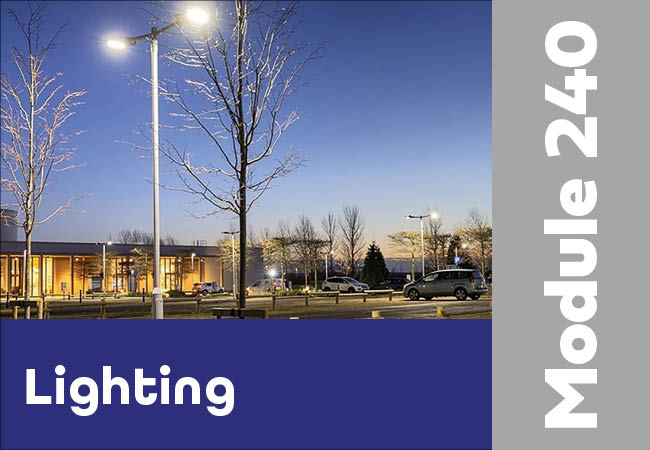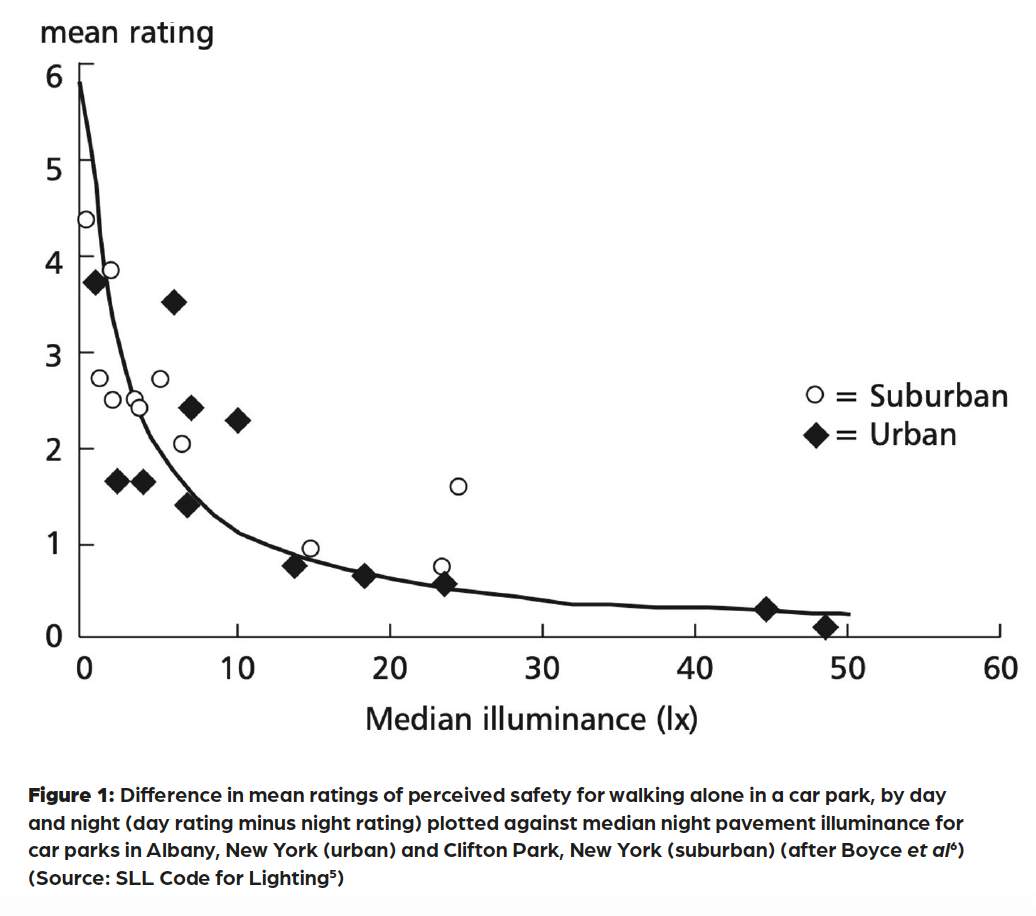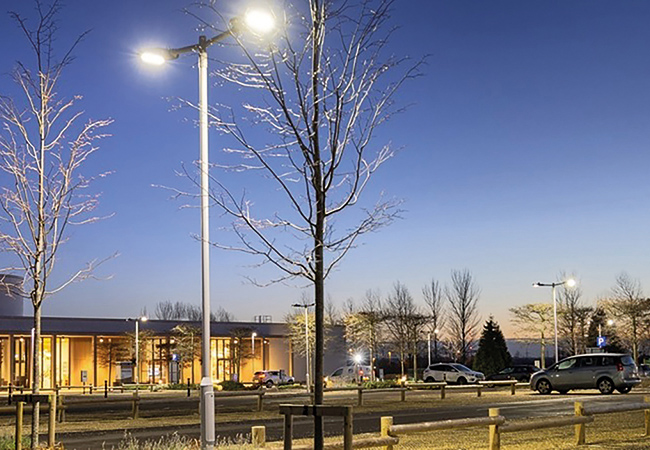

Urban lighting significantly influences our perception of safety, security and overall quality of life. This CPD article draws on current Society of Light and Lighting (SLL) guidelines, plus themes and findings from recent research papers on the effects of urban lighting, to explore the human perception of safety in artificially lit urban settings.
The history of artificial lighting at night (ALAN) in public spaces dates back centuries. Early forms of public lighting can be traced back to ancient civilisations, which used oil lamps and torches to illuminate streets and public spaces.
In the 15th century, London and other English cities implemented regulations requiring residents to light their homes at night, but this was primarily for safety and security reasons rather than a formal public lighting system.
The development of gas lighting in the 18th and 19th centuries marked a significant advancement in public lighting. Cities such as London and Paris began to install gas streetlamps that provided more consistent illumination, and these systems were maintained professionally, marking the beginning of modern public lighting infrastructure.
The temperature and intensity of light influence perceptions of brightness and safety. Studies, including that by Li et al,1 consistently show that warmer colour temperatures (lower Kelvin values) generally enhance feelings of safety, even at the same illuminance levels as cooler light. This could be because warmer light is less disruptive to natural circadian rhythms and is associated with more relaxing environments.
Some studies suggest the spectral sensitivity of human vision under low-light conditions (mesopic vision – see boxout) might mean that ‘whiter’ light sources could offer better visibility for certain tasks. But existing metrics, such as lux (lx), that focus on light intensity might not accurately reflect human perception of brightness, as they don’t fully account for the interplay of rod and cone cells at night.
A certain lux level might appear brighter to a person with a higher density of rod cells compared with someone with a lower density. To address this, researchers are exploring more sophisticated metrics that consider the interplay between rod and cone cells.2
An important aspect of ALAN is that it is a significant environmental stressor impacting biodiversity and human health. As discussed in SLL LG21,3 to protect the night-time environment, it is best to avoid installing exterior lighting unless absolutely necessary.
Unshielded urban lights create a diffuse glow in the sky, negatively affecting nocturnal habitats and species adapted to natural light cycles. According to a 2022 study: ‘A recent skyglow model suggests that about 80% of the world’s population now lives under light-polluted skies… which poses a serious threat to biodiversity and human health.’4
Even dim ALAN can disrupt melatonin production in various species, affecting crucial day-night cycles, the study suggests: ‘ALAN can also suppress melatonin, known as the night hormone, in various vertebrate species even at skyglow-like low light levels (0.01-0.03lx)… This may inhibit crucial day-and
night-time cycles.’4
However, there are many applications that would normally deserve at least some investigation around the appropriate application of external lighting, such as on roads, cycle routes and pathways, to ensure safe movement. It might also be considered to enhance security by enabling surveillance in areas such as car parks, and allow work to be carried out in places such as transport hubs.

Additionally, exterior lighting can extend the use of outdoor facilities, such as sports pitches, and prolong economic activities in areas such as town centres, as well as highlight landmarks or structures, including historic buildings and bridges.
As discussed in the SLL Code for Lighting,5 while lighting can play a role in crime prevention, its effectiveness is not guaranteed. Increased lighting can deter crime by making it harder for criminals to operate undetected and by boosting community confidence. However, lighting alone may not directly reduce crime rates. To be effective, lighting must be well designed, providing adequate illumination, uniform distribution, minimal glare, and a suitable light spectrum. This allows people to identify potential threats and take action, while also enabling witnesses to provide accurate information to authorities. Ultimately, the effectiveness of lighting in crime prevention depends on various factors, including the type of crime, the community’s overall environment, and the presence of other crime-prevention measures.
The most straightforward way that lighting impacts actual safety is by improving visibility. Being able to clearly see pathways, obstacles and other people is essential for avoiding accidents and recognising potential threats. While some light is undoubtedly better than none, research suggests that, beyond a certain level, increasing illuminance doesn’t necessarily lead to a proportional increase in perceived safety.
This is important because simply adding more light fixtures has ecological and financial costs. Uneven illumination creates stark contrasts between light and shadow, potentially obscuring potential threats and contributing to feelings of unease. Conversely, well-distributed light reduces hiding spots and enhances visibility, fostering a sense of safety. Harsh, glaring light can be uncomfortable, impair visibility, and create feelings of vulnerability. This is particularly true for older adults, who are more susceptible to glare-related vision issues.

Employing data published in the seminal paper6 by Boyce, the perception of safety by visitors experiencing night-time illuminance compared with daylight visits in car parks in two US cities – shown in Figure 1 – indicates a notable relationship between illuminance and the perceptions of safety in the car parks.
At a sufficiently high illuminance, the difference in ratings of perceived safety for day compared with night approaches zero. For illuminances in the range 0lx to 10lx, small increases in illuminance produce a large increase in perceived safety. Illuminances in the range 10lx to 50lx show diminishing returns.
Many challenge the assumption that increasing illuminance directly translates to increased feelings of safety. Specifically, studies suggest that beyond a certain threshold (around 5lx to 17lx7), the positive impact on safety perceptions plateaus, even as illuminance continues to rise. The level of illuminance considered ‘safe’ can vary significantly based on the environment and individual expectations.
For instance, people accustomed to brightly lit urban areas might perceive lower light levels as less safe compared with those living in rural settings.7 A recent investigation by Jedon et al8 considered how spectral composition and intensity influences alertness and arousal levels, impacting pedestrian behaviour and safety.
They note that psychological constructs such as alertness, vigilance and/or anxiety are not generally considered in pedestrian lighting research, as it mainly focuses on visual performance. They assert that exploring concepts such as alertness, arousal and anxiety could provide a deeper understanding of pedestrian safety.
They consider that, in particular, arousal – the body’s way of preparing for action or heightened awareness – seems promising, as it can be influenced by various environmental factors beyond lighting.
Research, including that by Lis et al,9 indicates a strong link between lighting design in urban parks and perceived safety. The study found that park lighting, which enhances ‘spatial legibility’ (how easily people can understand and navigate through a space), significantly impacts people’s sense of safety depending on how different elements of the landscape are illuminated.
Path lighting alone did not improve safety perceptions and reduced legibility, while lighting the surrounding horizontal and vertical elements improved spatial legibility and the sense of safety. Background lighting also boosted safety and preference by making the space more legible and mysterious, while excessive foreground lighting decreased safety and privacy. Respondents preferred lighting that balanced legibility and mystery while preserving privacy, which increased their overall preference for the park.
Glare can impact visual comfort and even safety, particularly for pedestrians. Abboushi et al recently examined10 several models proposed over the years that have attempted to predict discomfort from glare.
Within the constraints of the datasets that they employed, and considering seven different models, they determined that the direct illuminance from the source, with the intensity of light falling directly from the lamp onto specific areas, such as paths and roads, was practically the most suitable model, as it tended to offer similar or better predictions than the other models.
They also noted that factors such as age can influence glare perception, with older individuals potentially more susceptible to discomfort glare.
Numerous studies have indicated that the presence of other people significantly influences perceptions of safety, often more so than lighting itself. Well-lit spaces that encourage social interaction and create a sense of community can contribute to actual safety by reducing the likelihood of crimes of opportunity.
In a recent study, Hamoodh et al11 examined how lighting conditions can impact how pedestrians perceive others based on subtle cues such as facial expressions and hand gestures. The work supported the assumption of previous lighting research that the face is an important visual cue for the interpersonal evaluations necessary for a pedestrian to feel safe.

Appropriate lighting can enable accurate interpersonal evaluation by making these visual cues more discernible, particularly at night when natural visibility is reduced. An example of providing this in an open area is illustrated in Figure 2.
Individual perceptions of safety are shaped by personal experiences, background, and familiarity with different environments.11,12 Factors such as age, gender and cultural background can influence how people perceive and respond to different lighting conditions and urban environments. This undoubtedly increases the challenge of providing a universally acceptable night-time environment.
There are increasing opportunities offered by manufacturers for what is sometimes termed ‘smart’ control, but there appears to be limited independent reports on the consequences of advanced control techniques. ‘Smart’ and more traditional control techniques recently reviewed13 by Welsh et al, illustrate the variability and complexity that, in some cases, may lead to unintended consequences, such as crime displacement, while, in others, deliver a variety of benefits.
To create safer, more sustainable urban environments, lighting designs need to reach beyond merely maximising illuminance. Prioritising lighting quality, tailoring strategies to specific contexts – which will probably include the application of carefully considered controls – and fostering collaboration can achieve a holistic approach that balances safety, comfort, energy efficiency and ecological responsibility.
Further research is needed to fully understand the complex interplay of factors that influence perception of safety, behaviour and environmental sustainability. This will enable the development of increasingly effective lighting guidelines for urban areas.
Vision in focus
Photopic vision: This type of vision occurs under well-lit conditions, typically during the day. It is dominated by cone cells in the retina, which are responsible for colour vision and high visual acuity.
Scotopic vision: This vision type occurs under low-light conditions, such as at night. It is dominated by rod cells, which are more sensitive to light but do not detect colour.
Mesopic vision: This is a combination of photopic and scotopic vision, and occurs under intermediate lighting conditions, such as dawn or dusk, and is characterised by reduced colour perception and visual acuity.
© Tim Dwyer 2024.
References:
- Li, Y et al, Effects of illuminance and correlated colour temperature of indoor light on emotion perception, Nature Scientific Reports, 2021, bit.ly/CJNov24CPD21.
- Bullough, J D et al, Impacts of average illuminance, spectral distribution, and uniformity on brightness and safety perceptions under parking lot lighting, Lighting Res. Technol. 2020; 52: 626–640, bit.ly/CJNov24CPD22.
- SLL Lighting Guide 21: Protecting the night-time environment, CIBSE SLL.
- Vega, P et al, A systematic review for establishing relevant environmental parameters for urban lighting: translating research into practice, Sustainability 2022, 14, 1107, bit.ly/CJNov24CPD23.
- SLL Code for Lighting, CIBSE SLL, 2022.
- Boyce, P R et al, Perceptions of safety at night in different lighting conditions, Lighting Research and Technology 2000.
- Fisher, B S and Nasar, J L, Fear of crime in relation to three exterior site features: prospect, refuge, and escape, Environment and Behavior, 1992, 24(1), 35-65, bit.ly/CJNov24CPD24.
- Jedon, R et al, Proposing a research framework for urban lighting: the alertness, arousal and anxiety triad, Lighting Res. Technol. 2023; 55: 658–668,
bit.ly/CJNov24CPD25. - Lis, A, How to light up the night? The impact of city park lighting on visitors’ sense of safety and preferences, Urban Forestry & Urban Greening 89 (2023).
- Abboushi, B et al, Predicting discomfort from glare with pedestrian-scale lighting: A comparison of candidate models using four independent datasets, Lighting Res. Technol. 2024; 56: 225–246.
- Hamoodh, K et al, Visual cues to interpersonal evaluations for pedestrians, Lighting Res. Technol. 2023; 55, bit.ly/CJNov24CPD26.
- Himschoot, E A et al, Feelings of safety for visitors recreating outdoors at night in different artificial lighting conditions, Journal of Environmental Psychology 97, 2024.
- Welsh, B et al, The impact and policy relevance of street lighting for crime prevention: a systematic review based on a half-century of evaluation research, 2024, bit.ly/CJNov24CPD27.
